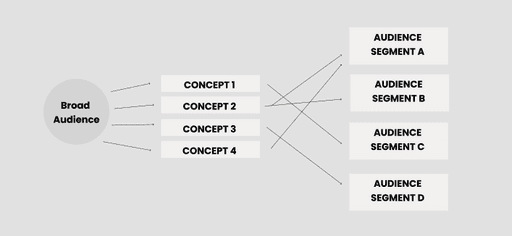Scaling Creative Development for Digital Ads: The New AI Driven Paradigm
As Facebook and Google become more automated, ad creative has emerged as the primary signal these platforms use for targeting.
Since targeting is now mostly automated, Facebook advises consolidating and running everything in broad audiences. Interest targeting can still work but isn't as scalable as letting Meta optimize based on dataset / pixel data.
To make broad audiences effective, you need diverse creative concepts and numerous variants. Instead of customizing creatives for specific interests, you create broad concepts and test them against a variety of ad creatives. Meta uses the ads themselves to serve to different audience segments.
Facebook uses Bayesian statistics to update prediction models based on actions such as clicks and video views and a number of engagements.
This new method simplifies the process and shifts the focus towards creativity rather than niche strategies.
Many advertisers will struggle with this change, but those who adapt are the ones with a chance to really thrive under this model.
The amount of creative you need depends on factors like your ad spend, the platforms you use, your target market size, and your desired ad frequency.
In the past, manually creating and testing target segments was cumbersome and costly. Now, platforms like Facebook and Google construct these segments using data from other ads and brands, and metrics like clicks and video views to determine the best segments for your ads.
While creative has always been important, it’s now crucial to have a consistent and systematic production process.
A repetitive and reliable system ensures you’re always prepared and not scrambling at the last minute.
Previously, you were limited by the number of segments you could construct and test due to time and cost constraints. Now, ad platforms create numerous targeted segments and run your ads against all possible segments, gathering data to inform future steps.
This automated segmentation pairs variants with the segments where they perform best, removing the guesswork.
Key takeaways from this new approach:
More Targeted User Segments: Ad platforms create many more segments than advertisers previously did.
Black Box Segmentation: Advertisers can’t see or define these segments, and platforms like Google and Facebook aren’t transparent about their methods.
Test a Lot of Diverse Creatives: To optimize advertising, you need to test numerous creatives. This helps platforms find the most resonant creatives for each segment.
How to Test Ad Concepts and Variants
Start with bold concepts—big ideas that aim for significant results. Incremental changes won't lead to major breakthroughs; you need big ideas for that.
For example, one ad could focus on time-saving, another on FOMO (fear of missing out). Variants then tweak these concepts, like changing button colors or text.
This framework ensures the best version of an ad surfaces from various permutations and variants.
It’s not easy—it involves art production, ad spend analysis, and understanding complex nuances. But a well-executed framework brings big rewards.
The Importance of Constant New Creative
Ads tend to revert to the mean over time, so you need new creative regularly.
Ads fatigue for various reasons, often because algorithms first target high-intent buyers and then move outward.
Develop a system to refresh ads before they drop off.
By the time an ad declines, have a new one ready. This maintains a constant cycle of high-performing creative.
Building a Creative Process
Developing a creative process involves several steps: concepting, producing variants, testing, monitoring, and iterating.
Repeat this cycle based on the number of ads needed. Key principles include:
Regularity: Maintain a consistent cadence.
Accountability: Clearly define roles and responsibilities.
Predictability: Ensure predictable launch and creative cycles.
Start with weekly creative meetings. Spend time on ideation, competitor analysis, and brainstorming. Identify creative needs, update on current production, review delivered creative, and prioritize new ideas. Use tools like Google Docs for a rolling list of ideas.
Each team should leave these meetings with clear actions. User acquisition teams should know which creatives are greenlit for testing and production.
The marketing design team should understand the changes needed. The creative director should manage the backlog and ensure the process runs smoothly.
Scaling advertising with effective creative development is essential in today's competitive landscape. By leveraging automation, investing in creative, and maintaining a structured process, you can achieve superior results.
Regularly refreshing ads, testing new concepts, and a disciplined workflow are key to sustained success.
Adopting these practices will optimize campaign performance and ensure dynamic, impactful advertising in an evolving market.
If you need help with creative production and you’re spending at least $20,000 a month, reach out. We’ve got a track record of scaling advertising spend profitably and producing rapid growth.



